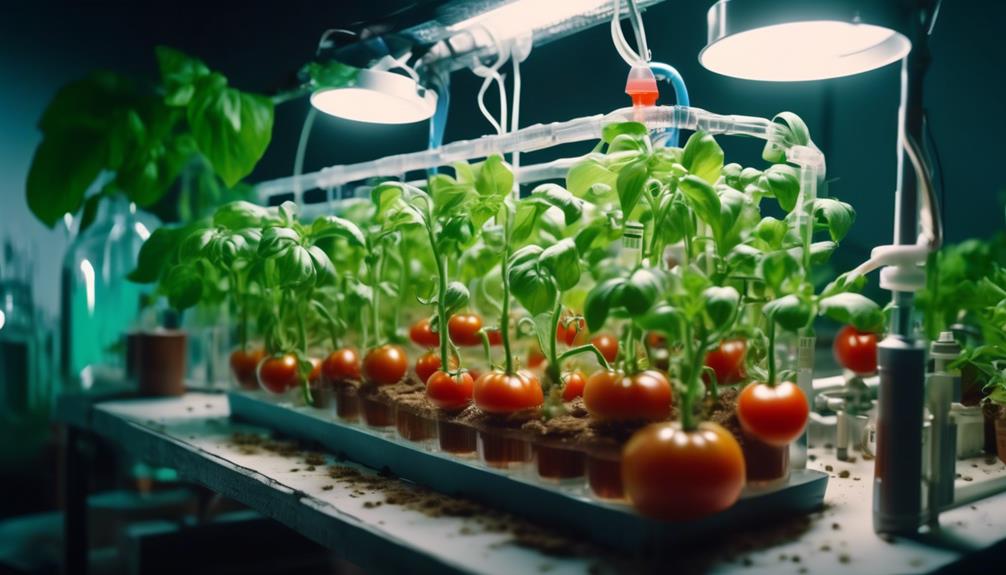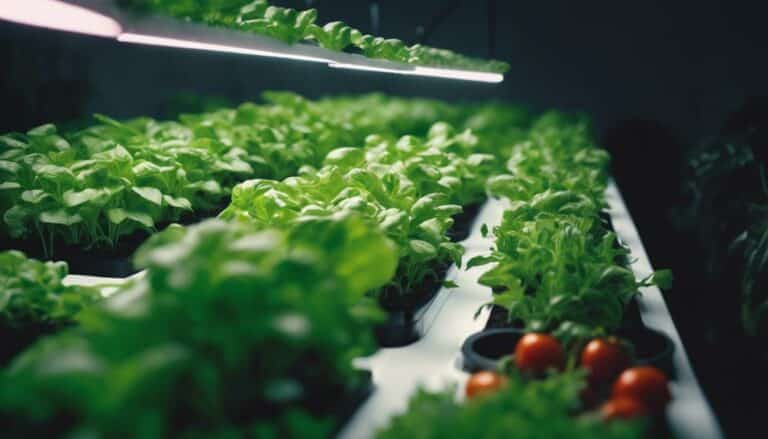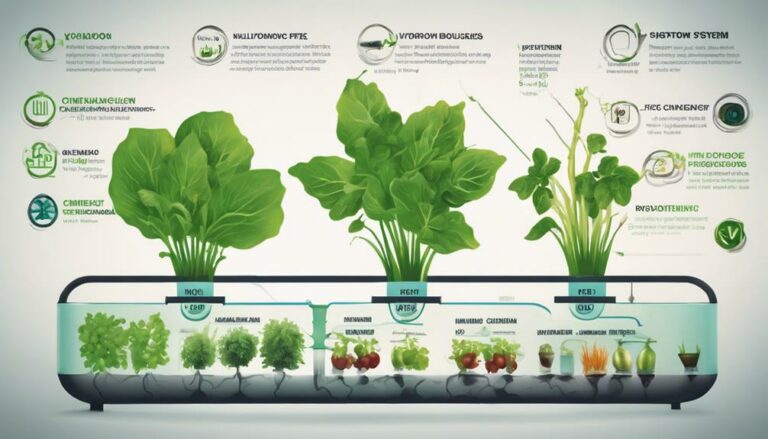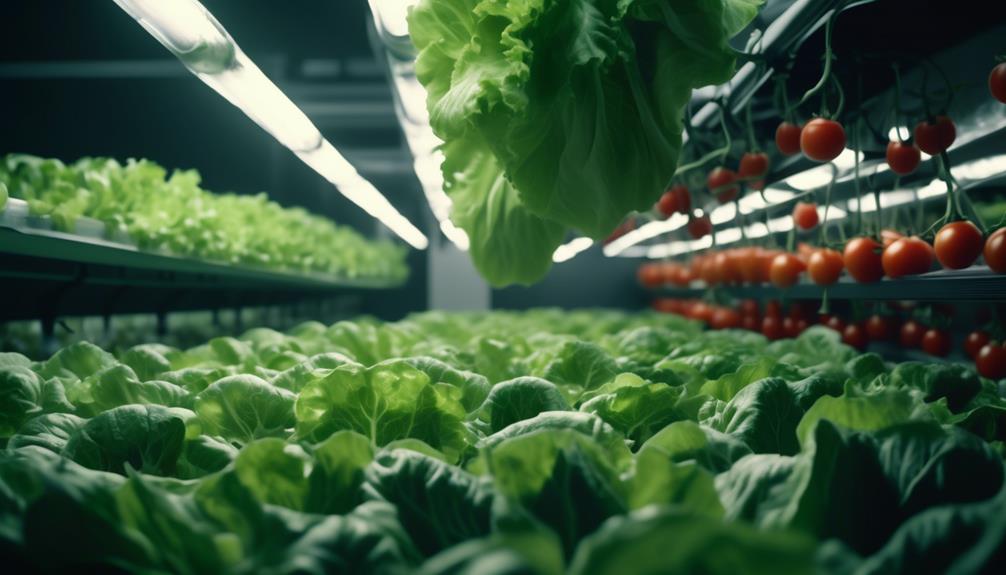Just as a maestro conducts an orchestra to create a flawless symphony, we must orchestrate the balance of essential nutrients to ensure our hydroponic tomato plants hit the high notes of health and productivity.
Table of Contents
In our practice, we’ve found that the absence of a single element can throw off the whole production, leading to stunted growth or poor fruit yield. We’re meticulous in crafting nutrient solutions that provide a full spectrum of macronutrients like nitrogen, phosphorus, and potassium, along with crucial micronutrients such as calcium, magnesium, and iron.
Our approach is practical, grounding our recommendations in solid evidence and experience to meet the nuanced needs of tomatoes at each stage of their growth. By sharing our strategies for adjusting nutrient concentrations and managing pH and electrical conductivity, we equip our fellow hydroponic enthusiasts with the tools for success.
As we peel back the layers of complexity surrounding nutrient solutions, let’s consider the delicate balance that must be maintained to foster lush, fruitful tomato plants in a water-based environment.
Identifying Key Nutrients
To ensure the robust growth of hydroponic tomato plants, it’s essential we identify the key macronutrients—nitrogen, phosphorus, and potassium—along with crucial micronutrients like calcium, magnesium, and iron, each serving unique functions throughout the plant’s lifecycle. We recognize that the precise balance of these essential nutrients directly influences the vigor of our hydroponic tomatoes.
We’re constantly assessing nutrient levels in our tomato nutrient solution to prevent nutrient deficiencies that can cripple plant development. Nitrogen (N) is pivotal for leaf growth, while phosphorus is integral for root and flower development, and potassium (K) aids in fruit quality and disease resistance.
Our attention to calcium (Ca) is unwavering, as it fortifies cell walls and mitigates blossom end rot. Magnesium supports chlorophyll production, essential for photosynthesis, and iron is vital for energy transfer within the plant. These elements are the building blocks of our hydroponic nutrient solutions.
Creating Balanced Solutions
Crafting the ideal nutrient mix for hydroponic tomatoes requires careful calibration of both macro and micronutrients to suit the dynamic needs of the plant at each stage of growth. We understand that a delicate balance is key to the success of our hydroponic tomato plants. Optimal nutrient solutions ensure that plants receive the right proportions of nutrients for vigorous growth and bountiful fruit development.
To maintain this balance, we closely monitor and adjust the pH levels, which can significantly affect nutrient availability. Altering the pH is critical because a slight deviation can lock out essential nutrients, hindering plant growth. We also measure electrical conductivity (EC) to assess the nutrient concentration in our solutions. A precise EC level indicates that our tomatoes are getting the right amount of nutrients without risking toxicity or deficiency.
As we navigate through the stages of tomato growth, we tailor our nutrient solutions to provide the exact nutritional support required at each phase. This responsive approach allows us to maximize productivity while maintaining the quality of the yield.
Adjusting Nutrient Concentrations
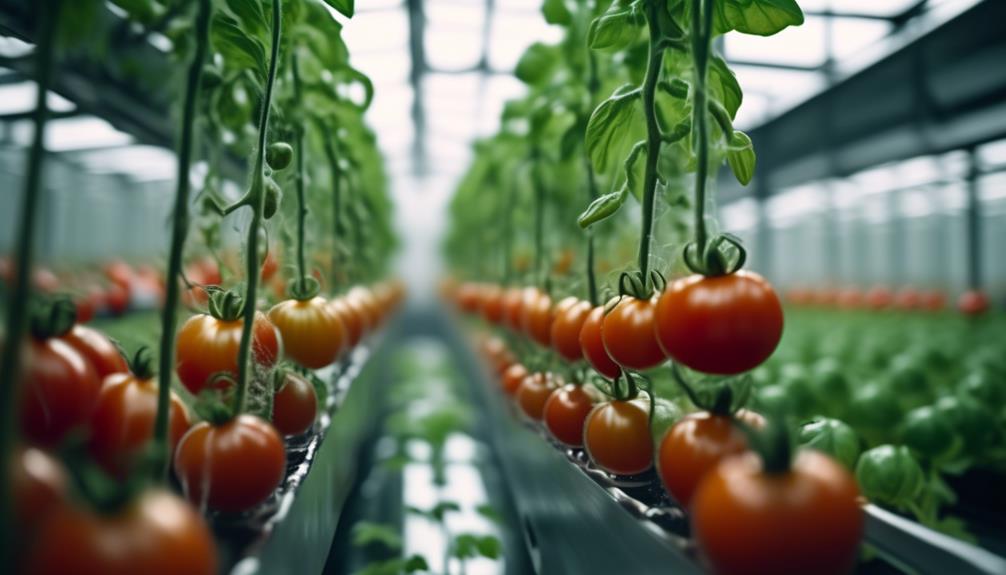
We meticulously adjust nutrient concentrations to accommodate the evolving requirements of our tomato plants throughout their different growth stages. For our hydroponic tomato crop, the adjustment of nutrient levels is a critical step that ensures each plant receives the optimal balance for its current phase of development. Young seedlings require lower concentrations to prevent excessive vegetative growth, while mature, fruiting plants need higher concentrations to support robust fruit development.
To ensure precision, we rely on three key practices:
- Monitoring EC (electrical conductivity) to gauge the strength of the nutrient solution.
- Maintaining the pH range within a tight window to optimize nutrient uptake.
- Assessing water quality regularly to prevent imbalances that could affect plant health.
Our nutrient solutions are specifically formulated for the distinct nutrient requirements of tomatoes at various growth stages. Adjustments are made using concentrated stock solutions, which allow for fine-tuning without the need for large volumes of water. This practice not only conserves resources but also reduces the risk of algae growth in diluted solutions that are stored for extended periods.
Managing Ph Levels
We’ve established the importance of nutrient concentrations, and now we must focus on managing pH levels effectively.
Hitting the optimal pH sweet spot between 5.5 and 6.5 is crucial for our hydroponic tomatoes, as it directly affects their ability to absorb nutrients.
We’ll explore pH adjustment techniques, including the use of acid injection and concentrated stock solutions, to maintain the ideal growing environment for our plants.
Optimal Ph Sweet Spot
To ensure the robust growth of hydroponic tomatoes, it’s crucial to maintain the nutrient solution’s pH within the ideal range of 5.5 to 6.5. We’ve found that this pH sweet spot optimizes nutrient availability, which is essential for vigorous plant growth.
It’s crucial to understand that while the pH of the nutrient solution is a starting point, the rootzone pH is a more critical factor.
- Adjustments to the drip pH can effectively manage rootzone pH.
- Rapid plant growth stages may require more frequent pH monitoring and adjustment.
- Acid injection into the nutrient solution can correct high pH levels, especially when using feed water with a high baseline pH.
Ph Adjustment Techniques
Understanding the critical role of pH in nutrient availability leads us directly to exploring practical techniques for managing pH levels in hydroponic systems. To grow hydroponic tomatoes successfully, we must adjust our pH to optimize the absorption of hydroponic nutrients. During different stages of growth, the root zone pH can fluctuate, especially with rapid plant growth phases where high nitrogen uptake can increase pH levels.
We use acid injection as a reliable pH adjustment technique, especially when feed water starts with a high pH. For precision, we measure the required acid per liter, adhering strictly to the nutrient film technique’s demands in our controlled environment.
Always, we follow the manufacturer’s guidelines when preparing our Concentrated Nutrient Solution, ensuring that our tomatoes thrive in the sweet spot of pH for maximum nutrient uptake.
Monitoring Electrical Conductivity
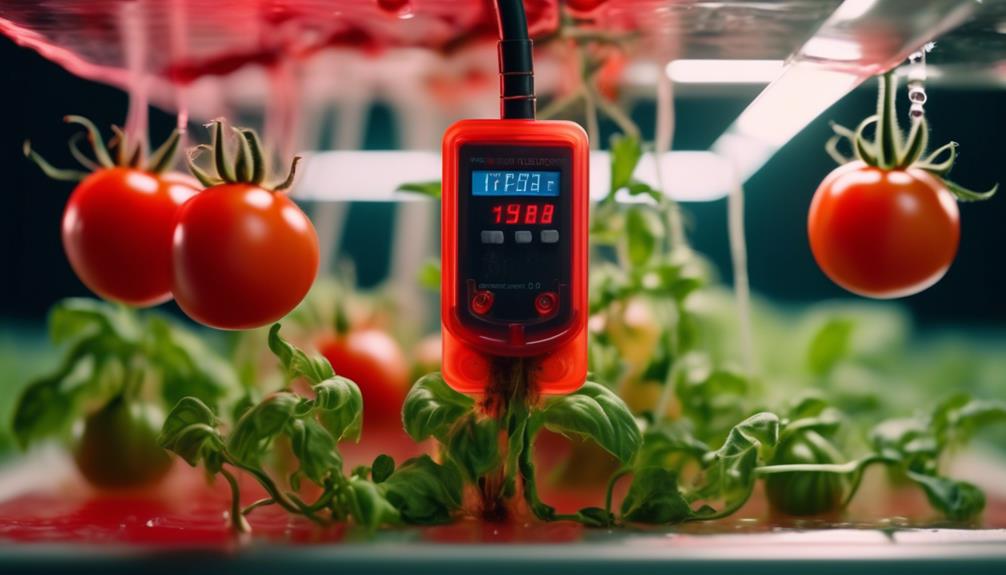
As we turn our attention to monitoring electrical conductivity (EC), it’s crucial to understand that the optimal EC range is key to robust tomato plant growth.
By keeping an eye on EC levels, we can precisely adjust nutrient strength, ensuring our plants receive just what they need.
This vigilance helps us prevent the detrimental effects of nutrient imbalances, safeguarding our hydroponic crop’s health.
Optimal EC Ranges
We must diligently monitor the electrical conductivity (EC) in our hydroponic system to ensure tomato plants receive the precise nutrient balance they need for each growth stage. Optimal EC ranges are pivotal for robust growth and development in hydroponic tomato cultivation. To sustain a thriving environment, consider these key points:
- The EC for young vegetative plants should be lower to encourage root development.
- As the plants mature, a higher EC supports the increased nutrient demands of fruiting.
- Fluctuations in EC levels signal the need for adjustments in nutrient solutions.
Ensuring the EC is high enough, yet within optimal ranges, means plants receive sufficient nutrients without the risk of toxicity. For hydroponic systems, maintaining EC between 1.5 to 2.5 mS/cm is generally recommended. Regularly calibrating our system against these standards secures the desired balance of concentrated nutrient solutions.
Adjusting Nutrient Strength
Monitoring the electrical conductivity (EC) of our hydroponic nutrient solution is crucial for fine-tuning its strength to match the specific needs of our tomato plants. We’re always striving for that sweet spot where the nutrient-rich water promotes robust growth rates without overwhelming our fruiting plants. By frequently checking and adjusting the EC, we ensure the essential nutrient solutions are neither too diluted nor too concentrated.
Achieving the right balance is key to optimizing plant health and ensuring high yields. In our hydroponics system, we’re vigilant about EC levels because they directly influence the uptake of nutrients. When we notice deviations, we’re quick to adjust nutrient strength, either adding more nutrients or diluting the solution, to maintain an environment where our hydroponic tomato plants can truly thrive.
Addressing Nutrient Deficiencies
To effectively address nutrient deficiencies in hydroponic tomato plants, it’s essential to identify the specific lacking elements and adjust the nutrient solution accordingly. We recognize the importance of tailoring essential nutrient solutions to the growth stages of tomato plants to prevent issues like blossom end rot during the flowering stage or stunted vegetative growth.
Our approach includes:
- Monitoring: Constantly check the root system and foliage for signs of deficiencies.
- Adaptation: Alter the nutrient mix in the growing medium based on observations.
- Precision: Use accurate measurements to adjust concentrations in the nutrient solutions.
For instance, if we spot the telltale signs of calcium deficiency, such as blossom end rot, we don’t hesitate to tweak our essential nutrient solutions to bolster calcium levels. Similarly, we address nitrogen deficiency—manifested by yellowing leaves—by increasing the nitrogen content to support lush vegetative growth.
We’re committed to innovating within our hydroponic systems, ensuring that our nutrient solutions aren’t only balanced but also responsive to the needs of our hydroponic tomato plants at every stage. By maintaining this level of attentiveness and adaptability, we can correct nutrient deficiencies swiftly and maintain a thriving crop.
Scheduling Feeding Cycles
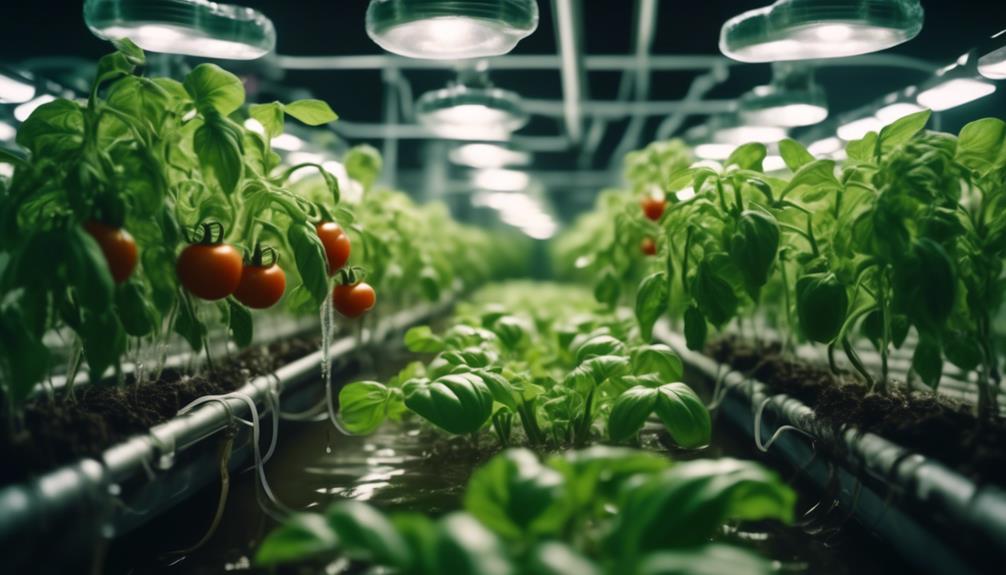
Having established methods to rectify nutrient deficiencies, our focus now shifts to optimizing feeding cycles to align with the distinct growth stages of hydroponic tomato plants.
As we delve into the art of growing hydroponic tomatoes, it’s crucial to realize that scheduling feeding cycles isn’t a one-size-fits-all scenario. Each stage of tomato growth demands a unique approach to the delivery of essential nutrient solutions.
During the vegetative stage, our hydroponic system pumps nutrient solutions rich in nitrogen to support lush, leafy growth. We fine-tune the concentration of these solutions, ensuring that our plants receive the precise nutrients they need to thrive without excess or shortfall.
As our tomato plants transition into the flowering and fruiting stages, we adjust our feeding cycles accordingly, shifting the balance towards a higher potassium and phosphorus content to encourage healthy blossoms and robust fruit set.
Efficiency is key in our operation, so we prepare nutrient stock solutions that can be easily diluted and dispensed. This method allows us to respond rapidly to the changing needs of our hydroponic tomato plants, adapting our nutrient solutions and feeding cycles with precision, thus ensuring that every tomato receives the optimal conditions for growth and productivity.
Frequently Asked Questions
What Is the Best Nutrient Mix for Hydroponic Tomatoes?
We’ve found that the best hydroponic tomato nutrient mix addresses tomato deficiencies with balanced nutrient ratios, includes organic alternatives, and considers root health, micronutrient importance, feeding schedules, temperature influence, water quality, and growth stages.
What Nutrient Solution for Hydroponic Tomato?
We’ve tackled the challenge of hydroponic tomato nutrition by focusing on tomato seedlings care, incorporating calcium nitrate, magnesium sulfate, and iron chelate, and monitoring for nutrient deficiency signs with savvy reservoir management and aeration techniques.
What Is the Most Important Nutrient for Tomato Plants?
We’re focused on ensuring our tomatoes get enough nitrogen, understanding potassium’s significance, meeting calcium requirements, recognizing magnesium’s importance, considering sulfur’s role, balancing micronutrients, ensuring iron sufficiency, and acknowledging zinc functions and boron’s contribution.
What Is the Best Ph and EC for Hydroponic Tomatoes?
We’ve found the best pH for hydroponic tomatoes hovers around 5.5-6.5, while optimal EC should be under 0.5 mS/cm, ensuring robust growth, vibrant health, and bountiful yields throughout all growth stages.

